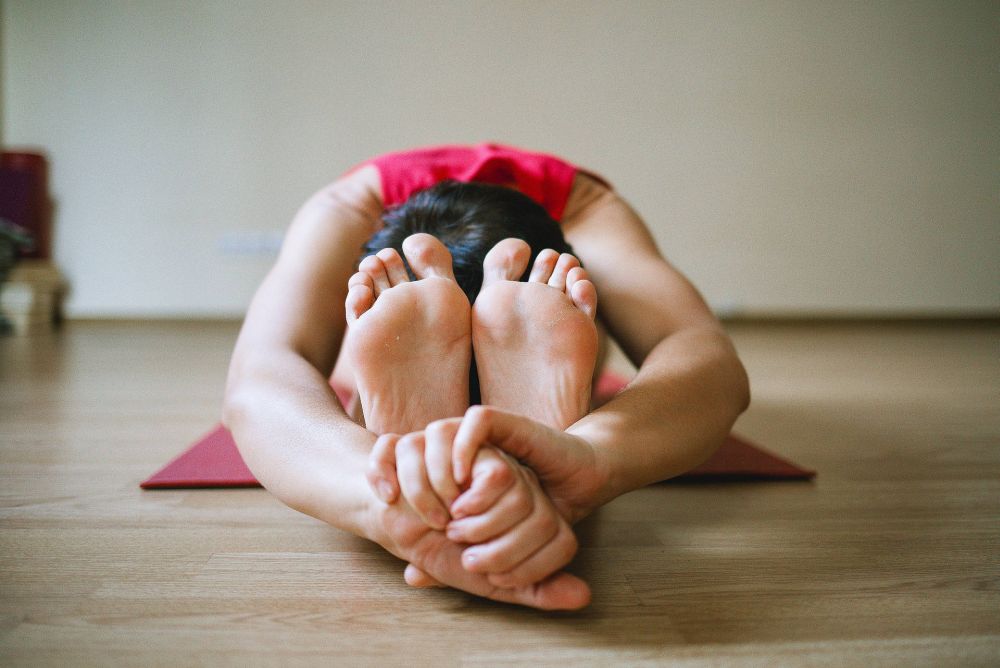
Have you been wondering for a long time how to do yoga at home? Did you finally decide to give it a try? You are not alone.
But don’t worry, it's much easier than you think and can help you lose weight. You can practice yoga at home for months without having to take a normal class.
You can easily move at your own pace when you practice yoga outside of the studio. It's one of the main advantages of doing yoga at home. You can start with beginner poses and gradually increase the difficulty as you feel comfortable.
You don’t have to be stressed out getting to the class on time or forgetting about your yoga gear. Furthermore, in a crowded studio, yoga cannot be as calming and relaxing as it should be.
You don’t have to spend hours on your practice when you are learning how to do yoga at home. It will save you time, money, and energy. But it's important to find your rhythm and listen to your body regularly.
Here are a few simple recommendations to start on how to do yoga at home:
- Get your yoga accessories ready.
- Always put safety first to prevent injuries.
- Choose a comfortable spot with no disturbance.
- Set goals for yourself that are reachable.
- Start with beginner poses leaving advanced ones for later.
- Stay motivated by practicing yoga regularly.
Panaprium is independent and reader supported. If you buy something through our link, we may earn a commission. If you can, please support us on a monthly basis. It takes less than a minute to set up, and you will be making a big impact every single month. Thank you!
1. Create a comfortable space to do yoga
Choose a very quiet and private place, with enough space to practice comfortably without any distractions. You need to prepare your yoga space right at home and store all your equipment there, including yoga mats, blocks, and blankets. Make sure that you won't be disturbed during your daily practice.
Pick a space that you can keep clean and quiet, well ventilated, and free from any furniture. Make it a sacred place where you can get some alone time for yourself to relax and progress. It doesn't have to be big, but large enough for you to feel comfortable in it.
2. Set goals for yourself and try to reach them

When starting with a home yoga practice, begin with standing poses for 10 to 15 minutes. You can think about which area of your practice you want to improve in. Think about what poses can help you get the results that you are trying to achieve.
You may want to set a plan in advance regarding how long your yoga routine should be and the most important poses you will have to do. Standing poses are great to warm up and stretch before moving on to more demanding sequences.
You might want to end your practice with restorative poses to relax. You can finish with meditation to ease your mind before going on with your day.
As you progress at home, you might want to include more difficult poses, including intermediate and advanced ones. You could try arm balances and inversions if you want to challenge yourself.
3. Practice beginner poses first

If you are fatigued, try a more relaxing style of yoga. If you feel energized and want to work out, more intense yoga styles like hot yoga, vinyasa, and ashtanga, or power yoga might be good for you.
Stay aware of all your sensations and emotions to make the most out of your practice. Use creativity and curiosity when learning how to do yoga at home instead of feeling competitive or judgemental.
Practice beginner poses first. Try to master them. Once you feel comfortable and want to do more, you can add difficulty and try more challenging poses.
4. Stay motivated, it's worth it
Practicing yoga in the morning is amazing for your body and your mind. You will feel fresh and relaxed by waking up early and taking time for this physical activity before going on with your day.
Yoga can increase your blood flow, boost your metabolism, help you focus, and fill your mind with positive thoughts. Just take a couple of minutes at first every day, to make it a habit. Motivation will come with practice.
Summing up:
There are many good reasons to start practicing yoga at home. You can improve faster when you regularly try out what you learned in class. And it is very relaxing to have some alone time during the day to focus on yourself.
Consistency is the key to success with a home practice. Make sure that you feel at ease every time and that you listen to your body. Set goals for your practice and start small to keep improving.
By picking a different style between vigorous or restorative practice each time, you can stay motivated, avoid boredom, and see amazing results with a bit of commitment and patience.
Was this article helpful to you? Please tell us what you liked or didn't like in the comments below.
About the Author: Alex Assoune
What We're Up Against
Multinational corporations overproducing cheap products in the poorest countries.
Huge factories with sweatshop-like conditions underpaying workers.
Media conglomerates promoting unethical, unsustainable products.
Bad actors encouraging overconsumption through oblivious behavior.
- - - -
Thankfully, we've got our supporters, including you.
Panaprium is funded by readers like you who want to join us in our mission to make the world entirely sustainable.
If you can, please support us on a monthly basis. It takes less than a minute to set up, and you will be making a big impact every single month. Thank you.































0 comments